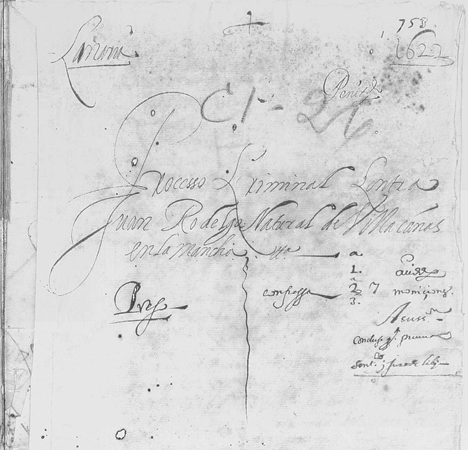The past couple of posts in this blog at the end of last year (2021) recounted the story of Juan Rodelgo, the young Spaniard who was captured by Algerine corsairs, converted to Islam, and eventually managed to escape in the Canary Islands. The details of his story come from the transcript of his trial by the Canary Islands chapter of the dreaded Spanish Inquisition. This trial took place in the autumn of 1622, on Las Palmas, on the island of Gran Canaria.
I thought readers might find it interesting to see a translation of the actual transcript itself.
The original Spanish-language Inquisitional document is part of the collection held by the Museo Canario, in Las Palmas. The trial transcript consists of 92 pages of faded, four-hundred-year-old, spidery handwriting—dark gray ink on pale gray paper. Putting Juan’s story together was a challenge, partly because the handwriting was difficult to decipher and partly because the transcript contains not only Juan’s testimony but also the testimony of a number of witnesses who were called upon during the trial, and so the transcript does not present a clear sequential narrative. Instead, it is mosaic of the different testimonies.
The crime Juan was on trial for was that of apostasy: renouncing his Catholic faith and converting to Islam. In his initial testimony, he lied to the Inquisitors and claimed to be an escaped Christian slave—that is, somebody who had retained his Christian faith. The Inquisitors believed him and released him. However, when the two captains leading the corsair expedition Juan had escaped from—Jan Janszoon and Calafate Assan—anchored at Las Palmas to ransom captives, word got out that Juan had been a renegado crewmember aboard their ships. He was then arrested, and the serious Inquisitional trial began, a lengthy process involving multiple witnesses. Mostly, that trial focused on religious matters. The details of Juan’s story—and his connection to Jan Janszoon—only emerge incidentally.
As a result of all this, the translation below is not the standard sort of word-for-word, page-by-page rendition. That standard approach would have produced an overly lengthy piece mostly containing details irrelevant to our purposes here. Instead descriptions of events that tell Juan’s story were teased out from the multiple testimonies and then stitched together to form the most coherent narrative possible.
Even using this approach, the best result possible was blocks of text that relate parts of the story, sometimes overlapping parts. To transform it any more, though, would have meant drifting too far from the original Spanish text. Where necessary for clarity, explanatory words or phrases have been added in square brackets. Otherwise, the translation differs significantly from the original only in that the text has been reordered so as to form a coherent narrative.
To my knowledge, this is the first time that any part of the transcript of Juan Rodelgo’s trial has been directly translated into English.

PROCESSO CRIMINAL CONTRA JUAN RODELGO NATURAL DE VILLACAÑAS EN LA MANCHA
(CRIMINAL PROCEEDINGS AGAINST JUAN RODELGO NATIVE OF VILLACAÑAS IN LA MANCHA)
Juan Rodelgo left Spain and was a soldier in Italy for two years. After returning to Spain for several years, he became a soldier again. On board a ship bound for Naples, near Cabo de Palos, which is near Alicante [near Cartagena], he was captured, along with many others, by Algerian corsairs who took him to Algiers, where he was sold to a Turk named Yusef. All this occurred in 1617. His owner had him in service carrying water and working in the vineyards and farming until 1621, when Yusef sent him to sea as a sailor with a corsair Captain named Soliman. Having returned to Algiers from that expedition, he was sent to sea as a sailor again, in this present year, with another captains named Calafate Hassan.
Juan then left to go en corso as part of an expedition consisting of twenty-one ships, led by Mamet Tagarino, an expulsado [from Grenada]. They passed through the Strait [of Gibraltar] and split into three squadrons. After they captured a French ship, they [the crew of the ship Juan was on] were ordered to take the captured vessel to Tétouan [to sell it and its cargo and crew]. As they neared Tétouan, they were attacked by two Christian ships and ran their ship aground [to escape]. Juan jumped ashore with the rest [of the crew].
That same night, he fled towards Tangier, walking at night and hiding by day to avoid being caught. After having walked two nights and come to within half a league of Tangier, he was caught by some Moors [Moriscos] of the land who had fled from the Christians [of Spain]. They asked Juan if he was a fugitive, and he responded he was not, but that some Arabs had robbed his crew and he had been separated from his comrades. Juan was taken to the Alcaide [the Morisco Commander]. Juan told the Alcaide that he was an Andalusian [i.e., a Muslim exile from Spain], as they could clearly see because he was circumcised. After confirming this, the Moors let him alone. He had said he was Andalusian for fear that if they knew that he was an escaped renegade, n they would hold him in Tétouan and punish him.
After having been with the Alcaide three days, Juan departed [overland] for Salé.

Corsairs and Captives
Narratives from the Age of the Barbary Pirates
View Amazon listing
The Travels of Reverend Ólafur Egilsson
The story of the Barbary corsair raid on Iceland in 1627
View Amazon listing